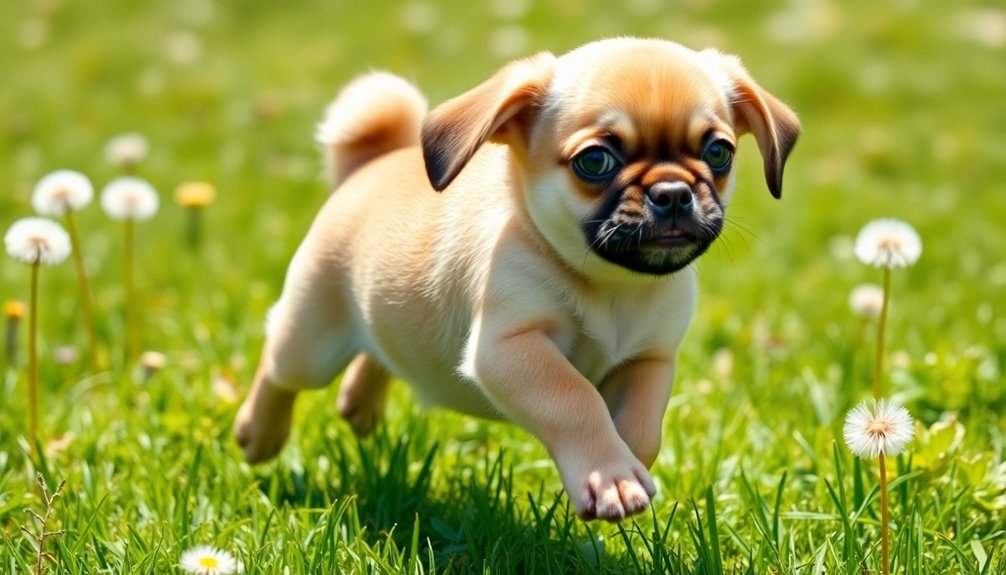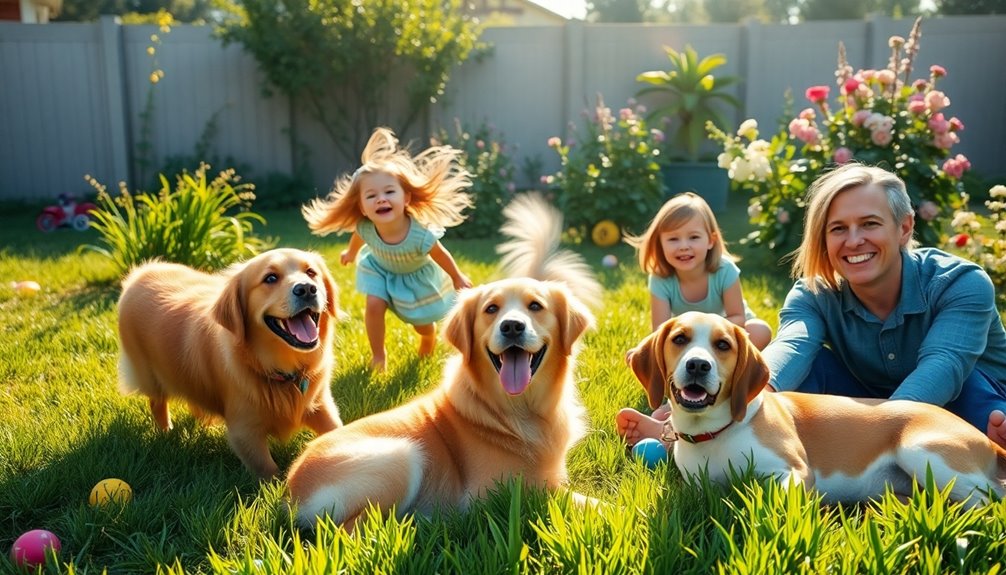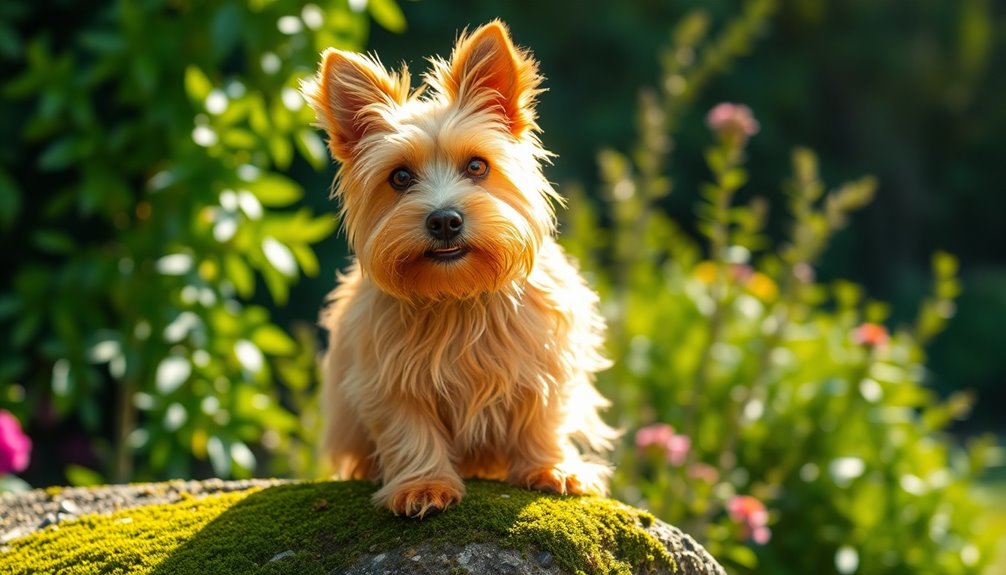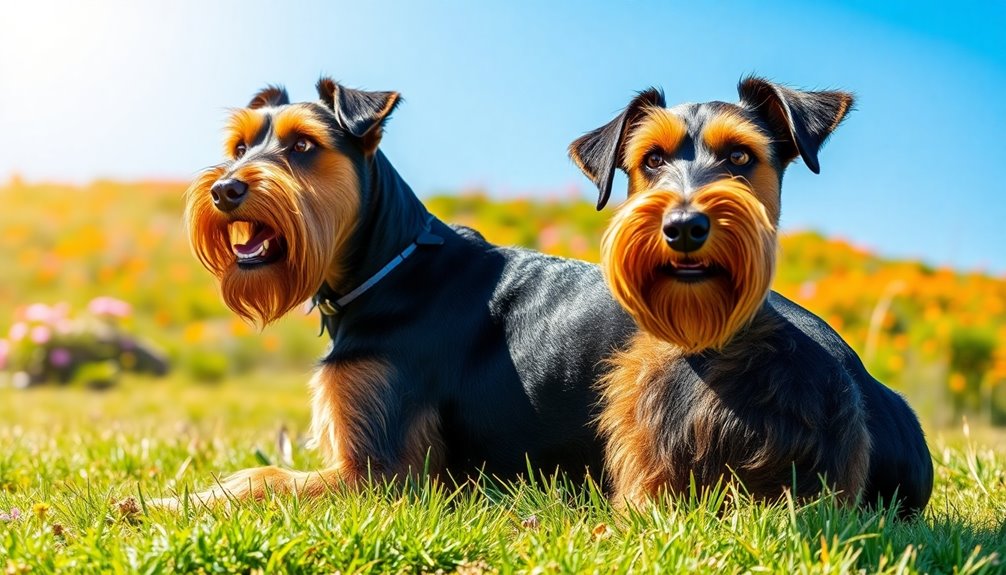Puggles are the perfect blend of Beagle and Pug, giving you an adorable and playful companion. They typically stand 8 to 15 inches tall and weigh between 15 to 30 pounds. With their friendly nature, they form strong bonds with family members and love being involved in all activities. Puggles thrive on companionship and require regular exercise—just 30 minutes daily—to keep them happy and healthy. Their charming round faces and expressive eyes make them hard to resist. If you think this mix might be the right fit for you, there's plenty more to discover about their care and characteristics.
Key Takeaways
- Puggles are a charming mix of Beagle and Pug, known for their friendly, sociable nature and strong family bonds.
- They have a compact build, standing 8 to 15 inches tall and weighing 15 to 30 pounds, making them suitable for apartments.
- With a playful demeanor, Puggles require at least 30 minutes of daily exercise and mental stimulation to keep them happy and healthy.
- Regular grooming is necessary, including weekly brushing and occasional baths, to maintain their short, dense coats and overall hygiene.
- Puggles are moderately intelligent and benefit from positive reinforcement training, enhancing their social skills and behavior with family and other pets.
Introduction
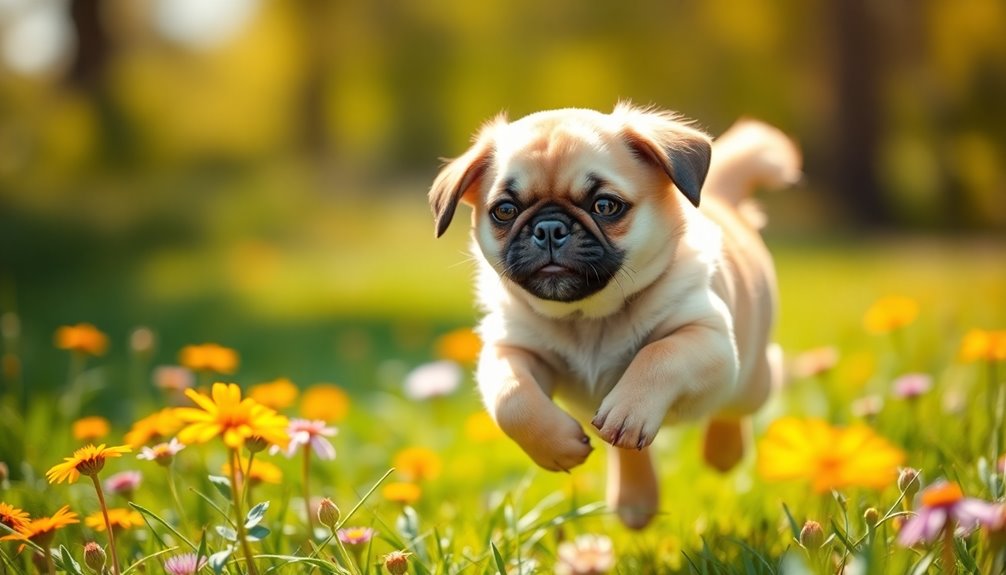
When you think of the perfect companion dog, the Puggle—a delightful mix of Beagle and Pug—might just come to mind.
These charming dogs typically stand between 8 to 15 inches tall and weigh between 15 to 30 pounds. Their compact, muscular bodies often feature a slightly elongated shape compared to a purebred Pug. With short, dense coats available in colors like fawn, black, and tan, Puggles sport a tail that usually curls over their back, reminiscent of their Pug parent, though some may have a straighter tail like a Beagle's.
Puggles are known for their friendly and sociable nature, enjoying the company of both people and other pets. They're affectionate and form strong bonds with family members, making them great companions. They are also generally good with other pets and thrive on companionship, which makes them an ideal addition to any household.
With a playful and energetic demeanor, they thrive on short walks and play sessions, though their stubborn streak can make training a bit of a challenge.
Suitable for families and adaptable to various living environments, Puggles require moderate social interaction and exercise, making them an excellent choice for first-time dog owners.
History and Origin
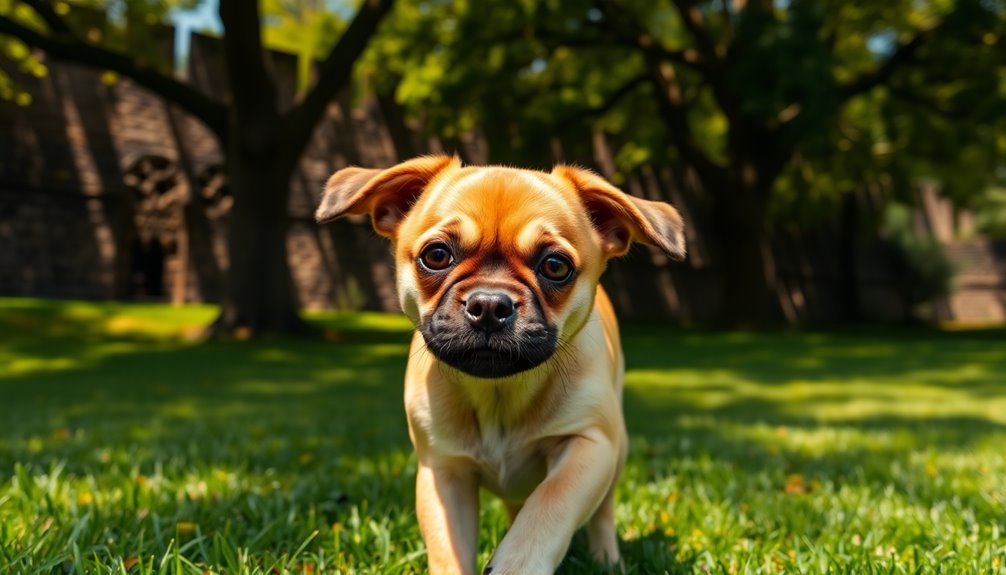
The Puggle originated in the 1980s in Wisconsin, thanks to Wallace Havens' goal of creating a small, energetic companion dog. This blend of pug and beagle not only aimed for a playful spirit but also sought to enhance family enjoyment through their affectionate nature. Over the years, Puggles have gained popularity as beloved pets across the United States, partly due to their energetic and friendly temperament.
Where and when the breed originated
Originating in the United States, specifically in Wisconsin during the 1980s, the Puggle was created by dog breeder Wallace Havens. His goal was to develop a small companion dog by combining the best traits of Pugs and Beagles. The first Puggles emerged from the careful cross-breeding of a male Pug and a female Beagle. This selection was intentional, as breeding with a Beagle mother mitigated health risks associated with larger male Pugs.
While some sources suggest the breed gained traction in the 1990s, it truly began to capture hearts in the early 2000s. It was during this time that commercial sales of Puggles took off, and the breed was registered with the American Canine Hybrid Club shortly after breeding commenced. Crossbreeding allows for the selection of desirable traits while also reducing faults, which contributed to the Puggle's appeal.
Although the Puggle isn't recognized as a standard breed in Europe, it enjoys some recognition in the U.S. through various clubs, even though there's no uniform breed standard. As a result, responsible breeders focus on selecting parent animals and providing health information, ensuring that Puggles inherit the lovable nature and intelligence from both parent breeds.
Companionship and Family Enjoyment
Puggles have quickly become beloved family companions thanks to their friendly and sociable nature. These playful pups thrive in family environments, easily bonding with children and other pets. Their gentle demeanor makes them ideal playmates, as they balance energetic playtime with affectionate cuddle sessions. With a patient attitude, they adapt well to various living situations, whether you're in an apartment or a house in the suburbs. Bullet points enhance readability and organization, making it easier for families to understand their Puggle's needs.
Socialization is key; early interaction helps Puggles get along with kids and other animals. While they generally coexist peacefully with other pets, they may need time to adjust, especially if they inherit their Beagle parent's prey drive. Additionally, engaging in consistent training methods can further enhance their social skills and behavior.
Supervised playtime with young children ensures safety for everyone involved, as even the sweetest Puggle deserves gentle handling. Training is a breeze with these intelligent dogs, though they can be a tad stubborn. Consistency in commands and positive reinforcement will yield the best results.
Ultimately, Puggles form strong family bonds, seeking closeness and companionship, making them a delightful addition to any household. With the right environment and love, your Puggle can bring endless joy and laughter to your family.
Physical Characteristics

When you look at a Puggle, you'll notice they're compact and muscular, standing between 8 to 15 inches tall and weighing 15 to 30 pounds.
Their short, dense coat can come in a variety of colors, often showcasing unique patterns that add to their charm. Puggles can exhibit colors that are typical for Pugs, such as fawn and black, enhancing their appeal.
With expressive eyes and curled tails, Puggles embody the playful spirit of both Pugs and Beagles.
Size, weight, and coat details
Standing at a height of 8 to 15 inches and weighing between 15 to 30 pounds, the Puggle is a compact and playful companion that fits well into various living situations. Both males and females generally fall within the same height range, making them suitable for apartments or homes with limited space.
However, you'll need to monitor their weight, as they can be prone to overeating and obesity. Puggles typically have a lifespan of 10 – 15 years, which adds to their appeal as a long-term family pet.
The Puggle sports a short, dense coat that's as charming as its personality. Coat colors vary widely, including fawn, black, tan, and combinations thereof. You might notice unique patterns like black and tan or tricolor combinations, with common white markings on the chest, paws, and face.
Fawn shades can range from light beige to a deeper reddish-brown, adding to their distinctiveness. While their coats are moderate shedders, they're not hypoallergenic, so be prepared for some fur around your home. Regular grooming helps manage shedding and keeps their coat looking its best.
Ultimately, the Puggle's size, weight, and adorable coat make them an excellent choice for anyone looking for a loving and lively pet.
Curly Tails and Expressive Eyes
With their charming curly tails and expressive eyes, Puggles showcase a delightful blend of their Beagle and Pug heritage. The curly tail, often inherited from their Pug parent, curls over their back, adding to their playful appearance. However, you might notice some Puggles have straighter tails, resembling that of a Beagle. This variation stems from genetics, and while the curly tail enhances balance and coordination during play, it can also lead to health concerns. Tightly curled tails may be prone to irritation and infections, so regular cleaning and monitoring are essential. Additionally, the curly tail is recognized as a symbol of good breeding, reflecting the breed's historical significance.
Now, let's talk about those expressive eyes. Puggles inherit large, slightly protruding eyes from their Pug lineage, giving them an adorable, soulful look. Their faces feature some wrinkles, especially around the forehead and muzzle, but they're less pronounced than a purebred Pug's.
The muzzle itself is longer than a Pug's yet shorter than a Beagle's, creating a rounded face that's both cute and captivating. This combination of features makes Puggles not just playful companions but also unique, charming pets that are hard to resist.
Temperament and Personality

When you think of a Puggle, picture a playful and sociable companion that thrives on interaction with family, friends, and other pets.
Their friendly demeanor makes them a great fit for families or individuals looking for a loyal pet that enjoys being part of the action. With their playful nature and love for companionship, Puggles can bring joy to any household. Regular exercise and mental stimulation are essential for their happiness and health, ensuring they remain energetic and engaged with their surroundings. Additionally, providing a diet with high-quality ingredients can further support their overall well-being.
Playful and Sociable Demeanor
Puggles are known for their vibrant and sociable demeanor, making them delightful companions for families and individuals alike. Their outgoing and friendly personalities shine through, as they love meeting new people and other animals. This sociability stems from their Pug heritage, which craves human interaction, combined with the Beagle's curious nature.
While they're generally good with strangers, you might notice them barking to alert you to new visitors.
Playfulness is another hallmark of the Puggle. With a Beagle's hunting instincts, they thrive on engaging activities like fetch or hiking, requiring about 30 minutes of exercise daily to stay happy and healthy. Without enough stimulation, they can get bored, which might lead to digging or excessive barking. This need for daily exercise is crucial for their overall well-being.
Puggles also form strong bonds with their families, seeking physical closeness and affection. Their "velcro dog" reputation means they love cuddling up with you.
However, be mindful that they can feel anxious when left alone for long periods due to their loyal nature. Overall, their playful and sociable demeanor makes Puggles an appealing choice for anyone looking for a loving and interactive companion.
Suitability for families, individuals, or other pets
For families, individuals, and other pets alike, Puggles offer a warm and engaging presence that makes them a desirable addition to any home. They're affectionate and form strong bonds with family members, enjoying cuddles and playtime. Their patient and gentle nature makes them great companions for children, though you should supervise interactions to ensure safety. Additionally, providing a balanced diet is essential for maintaining their overall health and energy levels.
If you're a single person or a first-time dog owner, Puggles adapt well to various living environments, whether you live in an apartment or a rural area. Their moderate care needs, including low-maintenance grooming and daily walks, fit seamlessly into busy lifestyles. Plus, their affectionate disposition means they'll always be eager for companionship. Notably, Puggles are a designer breed aimed at healthier dogs with fewer genetic issues, enhancing their appeal.
Puggles generally get along with other pets, especially if socialized early. While they can coexist with cats, keep an eye on their Beagle-inherited chase instinct. Early socialization is crucial for peaceful interactions with other dogs. Regular training and positive reinforcement can further improve their adaptability in multi-pet households.
However, be mindful of potential separation anxiety; they don't like being left alone for long periods. With regular exercise and a balanced diet, you can enjoy the playful and loving nature that Puggles bring to your life.
Health and Lifespan

When you bring a Puggle into your home, it's essential to be aware of their typical lifespan, which ranges from 12 to 14 years. This playful mix is prone to certain health issues, including breathing problems and skin infections, so staying vigilant is key to their well-being. Regular veterinary care and a balanced diet can help ensure that your Puggle lives a long and healthy life, potentially reaching their typical lifespan.
Typical lifespan of the breed
The typical lifespan of a Puggle ranges from 10 to 15 years, a duration that reflects the longevity of its parent breeds, the Beagle and the Pug. This lifespan can vary based on several factors, including genetics, diet, and overall care.
To maximize your Puggle's lifespan, aim for the upper end of this range by providing proper care and attention. Genetics play a significant role in determining how long your Puggle will live. A well-balanced diet is crucial, ensuring that their nutritional needs are met. Regular exercise, like daily walks and playtime, is essential for maintaining both physical and mental health. Additionally, Puggles require daily activity to prevent boredom and encourage engagement.
Don't forget the importance of regular veterinary check-ups, as preventive care helps catch potential health issues early. Additionally, weekly brushing and dental care are vital for grooming and preventing dental problems.
Keeping your Puggle at a healthy weight will help avoid obesity-related concerns. Lastly, ensure your furry friend has companionship and mental stimulation, which can contribute to a happier, healthier life.
Common health concerns or genetic predispositions
What common health concerns should you be aware of with a Puggle? Puggles inherit traits from both Pugs and Beagles, making them prone to several health issues.
Hip and knee problems are common, as are respiratory issues, though they're usually less severe than in Pugs. Due to their genetic background, you should also watch for bone and joint health issues, including arthritis. It's important to note that Pugs face increased risk for 23 disorders, which can also affect Puggles due to their shared lineage.
Obesity is another concern; Puggles love to eat and can easily overindulge. Keeping a close eye on their diet and ensuring regular exercise is essential to prevent obesity-related health risks like diabetes and heart disease.
Additionally, be mindful of specific conditions such as skin fold infections and eye problems, which can arise due to their facial structure and inherited traits.
There's also a potential risk for spinal abnormalities and heart conditions from their Pug lineage.
To mitigate these risks, regular veterinary check-ups and genetic testing are recommended. Responsible breeding practices that prioritize health can significantly improve the overall well-being of your Puggle, ensuring a happier, healthier life.
Tips for maintaining health and wellness
To ensure your Puggle enjoys a long and healthy life, focus on a balanced diet, regular exercise, and routine veterinary care.
Start by providing a balanced diet that includes proteins, healthy fats, and carbohydrates. Aim for about 30 calories per pound of body weight daily and split their food into two meals, giving them 1 to 1½ cups of food each day. Measure portions carefully to avoid obesity. Puggles are predisposed to health issues such as hip dysplasia and breathing difficulties, so monitoring their diet is particularly important. Additionally, it's useful to consult a veterinary nutritionist to ensure their diet meets all nutritional needs.
Regular exercise is key, so take your Puggle for 15-minute walks twice daily and incorporate playtime to keep their energy levels up. Mental stimulation is just as important, so invest in puzzle toys and training exercises. Always supervise them outdoors, keeping them leashed in secure areas.
Don't overlook grooming; brush their coat weekly, trim their nails, and clean their ears to prevent infections. Regular dental care and cleaning skin folds are essential too.
Schedule routine veterinary check-ups to catch any health issues early and maintain vaccinations. Monitor their weight closely, adjusting diet and exercise as needed.
Care Requirements
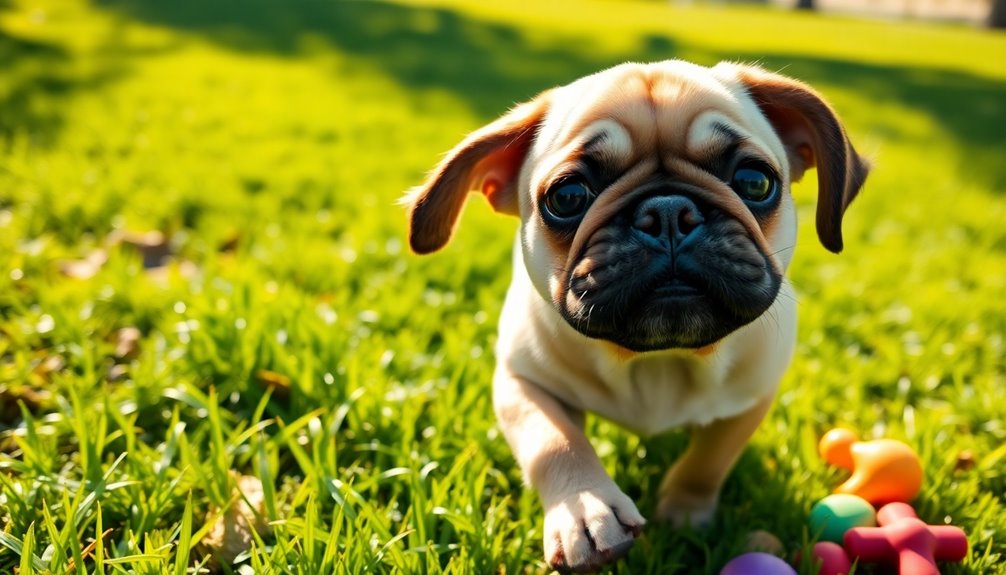
Caring for a Puggle involves meeting their exercise needs, which means you'll need to provide at least 30 minutes of physical activity each day. Their grooming is minimal, requiring just a brush once or twice a week to manage shedding. Additionally, you'll want to focus on a balanced diet to keep your Puggle healthy and prevent obesity. It's important to note that Puggles are prone to overeating, so establishing a consistent feeding schedule is essential.
Minimal Brushing Required
Brushing your Puggle is a simple task that can keep their coat looking great with minimal effort.
These adorable pups have short, dense coats that shed moderately throughout the year. To manage this shedding, you only need to brush them 1-2 times a week. Using a soft-bristle brush or a rubber grooming mitt works wonders in removing loose fur and reducing the amount of hair around your home.
Bathing your Puggle isn't a frequent requirement either. Unless they get dirty or smelly, bathing them every 1-2 months should suffice. It's important to use mild, hypoallergenic shampoo to avoid skin irritation, and always dry them thoroughly, especially between their skin folds.
Beyond coat care, you'll also want to pay attention to their ears. Puggles have floppy ears that can trap moisture, so check and clean them weekly with a vet-recommended ear cleaner. Regularly cleaning their ears helps to prevent wax buildup and infections.
Just remember not to insert anything deep into the ear canal.
With these simple grooming tasks, you'll keep your Puggle looking and feeling their best without much hassle!
Exercise requirements and energy levels
Grooming your Puggle keeps their coat healthy, but regular exercise is just as important for their overall well-being. Puggles need around half an hour of exercise each day, which can include short walks and engaging play sessions. Activities like ball games and interactive play aren't only fun but also help burn off their moderate energy levels. Incorporating mental stimulation, such as puzzles or games, is essential to keep them sharp and satisfied. Establishing a routine is vital for your Puggle. They thrive on predictable exercise times, which contribute to their health and happiness.
Consistent physical and mental activities prevent boredom and obesity, helping you manage their behavior effectively. Regular exercise also plays a crucial role in weight management, as Puggles are prone to obesity. Active breeds benefit from structured exercise to maintain a healthy weight, as without adequate exercise, they can face health issues like weight gain and lethargy. Engaging in regular physical activity can also improve their overall emotional health, as it reduces stress and enhances their mood.
Ensuring your Puggle gets enough activity helps maintain their overall physical and mental well-being. By sticking to a structured daily schedule, you can prevent common health risks associated with the breed while keeping your furry friend happy and fit.
Feeding tips and diet recommendations
To keep your Puggle healthy and happy, providing a balanced diet is essential. Focus on high-quality animal-based proteins like beef, chicken, turkey, and fish for muscle development. Include healthy fats to support energy levels and maintain a shiny coat.
Carbohydrates from vegetables, herbs, and berries provide quick energy, while vitamins and minerals from bones and supplements enhance overall well-being. Don't forget to add small amounts of fiber to aid digestion. Additionally, consulting a veterinary nutritionist can help ensure your Puggle's diet meets all of its nutritional needs.
Approximate daily caloric intake is about 30 calories per pound of body weight. For example, a 20-pound Puggle needs around 600 calories, divided into two meals. Monitor your Puggle's weight regularly and adjust food intake based on activity levels and health status.
When choosing food, select high-quality commercial dog food that meets AAFCO standards or consult a vet for homemade diets. Avoid fillers and additives, and consider adding natural supplements like glucosamine or omega-3 for extra health benefits.
Practice portion control to prevent obesity; treat limits shouldn't exceed 10% of daily calories. Opt for low-calorie treats like carrot sticks or apple slices.
Keeping your Puggle's diet balanced will lead to a longer, healthier life.
Training and Socialization
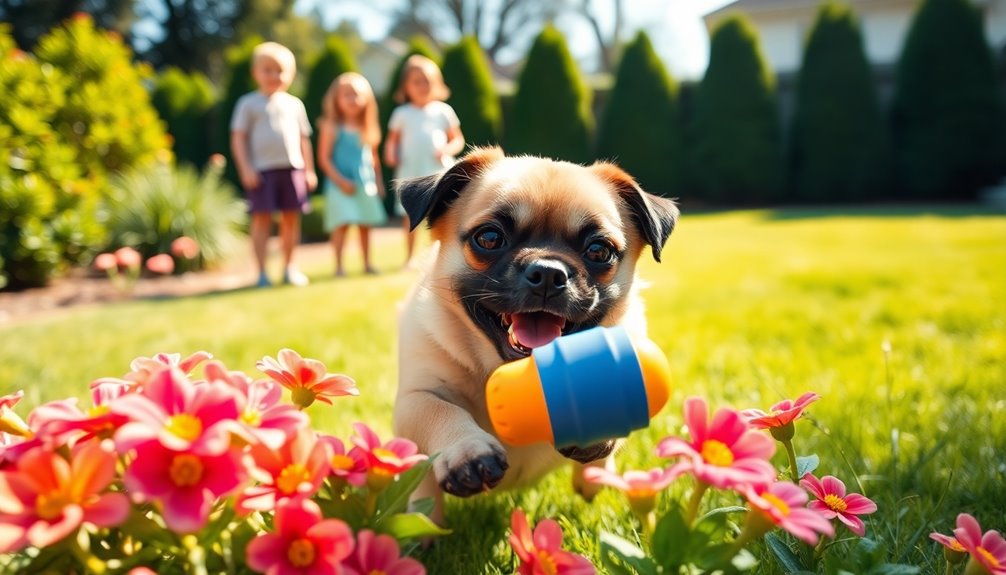
Training your Puggle can be a rewarding experience, especially since they're eager to please and moderately intelligent. Start with gradual introductions to new friends to help them feel comfortable, and focus on leash training to address any recall issues. With consistent practice and patience, you'll set your Puggle up for success in both training and socialization. Incorporating positive reinforcement techniques will further enhance their learning and motivation.
Moderate Intelligence, Eager to Please
Puggles, with their moderate intelligence and eagerness to please, make training a rewarding experience for both you and your furry friend. Their intelligence, inherited from both Pugs and Beagles, means they respond well to problem-solving activities. To make the most of their capabilities, consistent training is essential.
Using positive reinforcement is the best approach with Puggles. They thrive on treats, praise, and play, which enhances their willingness to follow commands. Focus on basic commands like "sit," "stay," and "come," using short, frequent training sessions for effectiveness. Incorporating clicker training can also help create a strong association between desired behaviors and rewards.
To keep your Puggle engaged, consider introducing smart dog toys and puzzles that provide mental stimulation. The key is to maintain consistency in your training methods, as this reinforces their eagerness to please. Additionally, recognizing a dog's body language is crucial for effective training, as it helps you understand their needs and responses better.
Training in various environments helps ensure they generalize their learning and adapt to new situations. With patience and dedication, you'll find that your Puggle not only learns commands but also builds a strong bond with you, making training a joyful journey for both of you.
Gradual Introductions to New Friends
When introducing your Puggle to new friends, patience and a gradual approach are key. Start by confining your Puggle to a separate room while your guests settle in. Choose a quiet, non-threatening area for the introduction, ensuring the new person is sitting down. Keep the initial interaction brief to avoid overwhelming your dog. Additionally, remember that dogs thrive on positive reinforcement to feel more secure in new situations.
Allow your Puggle to take the lead. Don't let the new person approach or touch your dog until it feels ready. Use positive reinforcement, like treats, to encourage confidence. Be patient—this process may take time, especially for shy or fearful dogs. Reward calm behavior around new people. Additionally, always prepare to observe body language to gauge your dog's comfort level during the introduction.
Monitor your dog's body language closely. If you notice signs of stress, take a step back. Gradually increase interaction time based on your Puggle's comfort level. Always end each interaction on a positive note to create a favorable association.
Leash Training and Recall Issues
How can you ensure your Puggle walks nicely on a leash and responds reliably to recall commands? Start with leash training techniques like the "Stop and Wait" method. If your dog pulls, stop and wait until they return to your side. Use gentle leash corrections and try changing direction to regain their focus. A no-pull harness can also help encourage loose-leash walking. Additionally, regular outings to pet-friendly cafes can provide diverse environments for practice.
For positive reinforcement, reward your Puggle with treats and praise when they walk beside you. Keep training sessions short and engaging to maintain their interest. Incorporate mental stimulation with puzzle toys to prevent restlessness. Loose leash walking promotes a relaxed environment, preventing reactive behavior towards distractions and ensuring a more enjoyable experience for both you and your Puggle.
When addressing recall issues, teach the "come" command with enthusiasm and generous rewards. Back up while calling your dog to encourage them to come to you. Use a consistent cue noise to signal them, ensuring they associate it with the command. Be patient and repeat this training regularly. Socialization is key, so expose your Puggle to various environments and controlled interactions. Consider enrolling in puppy classes for structured training, as they offer valuable socialization opportunities.
With patience and consistency, your Puggle will become a reliable walking buddy and a responsive companion.
Ideal Living Environment
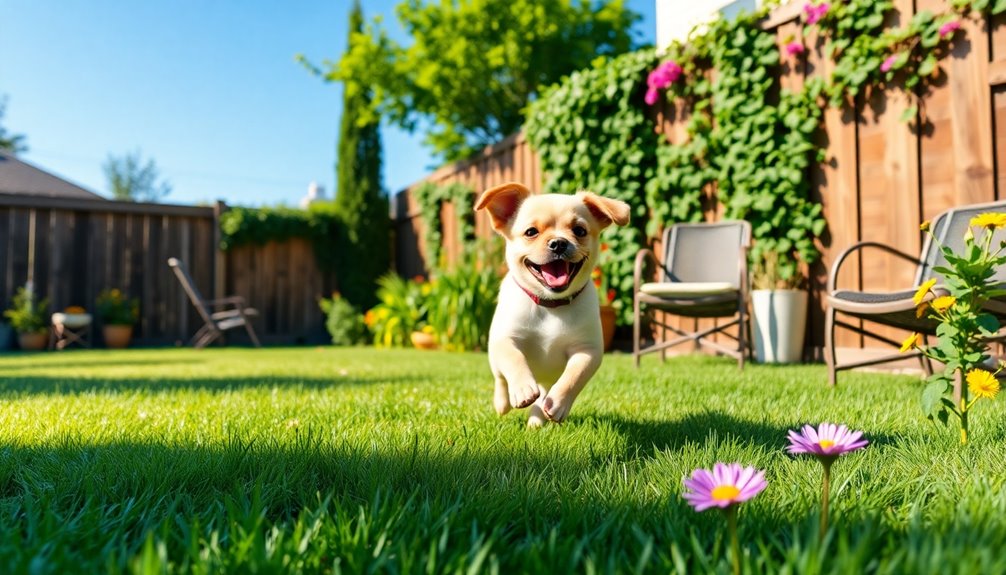
If you live in a moderate-sized apartment, a Puggle can thrive with enough space to zoom around and play. However, keep in mind their sensitivity to humidity in warmer climates; providing a cool, shaded area is essential. You'll need to ensure they get regular exercise and social interaction to keep them happy and healthy. Regular exercise is crucial for Puggles to maintain a healthy weight and prevent obesity.
Urban Apartment Living
Urban apartment living can be a suitable environment for Puggles, provided you meet their specific needs.
While Puggles require more space than purebred Pugs, they need less than Beagles, making them adaptable to smaller living spaces. Regular, short walks and indoor playtime will help satisfy their moderate energy levels, so ensure you dedicate time daily for physical activity. Without it, you might face behavioral issues or weight gain. Establishing healthy boundaries around playtime and rest can help maintain balance in their routine.
Keep in mind that Puggles can be vocal, inheriting barking tendencies from both breeds. Training and early socialization are important to minimize excessive barking, especially in noise-sensitive apartment communities. Additionally, opting for quieter breeds like Puggles can enhance the living experience in close quarters.
Accessibility is key; having a first-floor apartment or a balcony makes outdoor access easier for potty breaks. If you work long hours, consider hiring a dog walker or enlisting nearby help to maintain a consistent schedule for your Puggle's feeding and bathroom needs. Regular check-ins can also ensure that your Puggle receives the attention they need throughout the day.
Lastly, proximity to parks or green spaces will significantly enhance your Puggle's quality of life, providing ample opportunities for exercise and socialization. Engaging in shared experiences, like trips to the park, can deepen your emotional connection with your Puggle.
With the right approach, your Puggle can thrive in an urban apartment setting.
Humidity Sensitivity in Warmer Climates
Humidity sensitivity can pose significant challenges for Puggles living in warmer climates. High humidity hinders your dog's ability to cool down effectively. When the air is saturated with moisture, panting becomes less efficient, increasing the risk of overheating, heatstroke, and dehydration. Optimal humidity levels for Puggles fall between 30-50%, so you'll want to monitor these conditions closely.
Look out for signs of discomfort, such as excessive panting, drooling, or lethargy. If you notice a bright red tongue or vomiting, it's crucial to act quickly. Providing ample shade and fresh water is essential, especially during peak humidity hours. Limiting outdoor activities when it's muggy can help keep your Puggle safe. Additionally, be aware that pugs are particularly vulnerable to heat stress, which can also affect Puggles due to their similar physical traits.
Since Puggles have short noses and thick coats, they're particularly vulnerable to heat stress. Ensure your home is well-ventilated and consider air conditioning to help maintain a comfortable environment.
Regularly checking for signs of heat-related issues is vital, as is adjusting your dog's activities based on the weather. Prioritizing these measures will keep your Puggle healthy and happy in warmer, humid climates.
Puggles Excel in Agility Sports
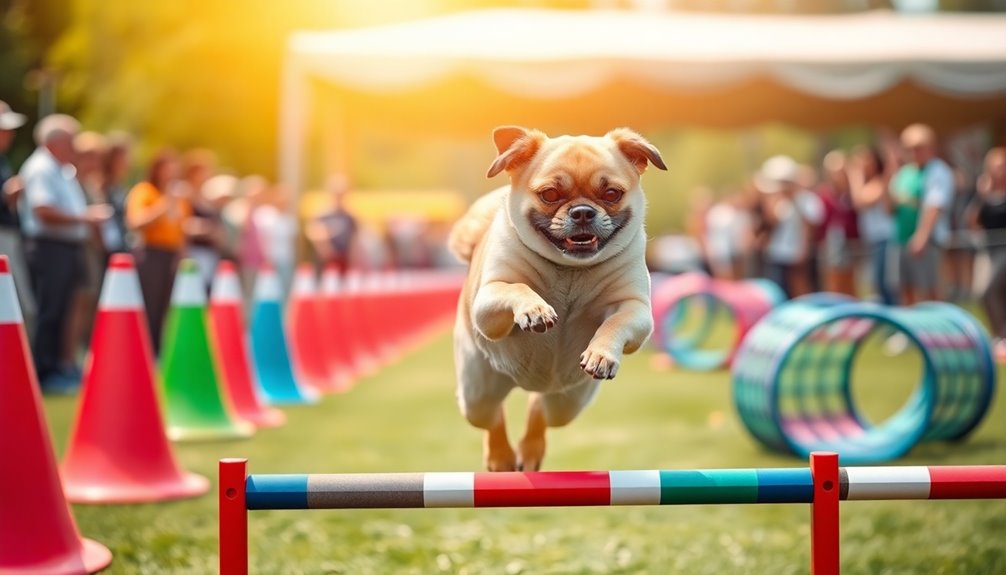
Puggles aren't just adorable; they also shine in agility sports, showcasing their playful nature and quick reflexes. You might notice their vocalizations reflecting both their Beagle and Pug heritage, adding to their charm during competitions. Plus, their antics often go viral, capturing hearts as they navigate courses with enthusiasm and skill. Their training benefits from canine conditioning, which enhances their body awareness and strength, making them even more adept at agility tasks.
Vocalizations Mimic Both Parent Breeds
Mimicking the vocalizations of their parent breeds, Puggles exhibit a unique blend of sounds that highlight their playful and alert nature. You're likely to hear barking when they're excited or when a stranger approaches. This barking is often loud and short, aimed at specific targets, like the postman or a passing squirrel.
However, when left alone or responding to high-pitched sounds, Puggles may howl, a trait they inherit from the Beagle. This howling can indicate separation anxiety and is usually longer and travels farther than their barks. In fact, their high-energy needs contribute to their vocalizations, as they may express frustration through barking or howling if they do not receive enough exercise.
In a social environment, you'll notice that indoor settings can amplify their barking, while howling may surface during times of separation. Puggles use these vocalizations to communicate their needs, excitement, or distress, making early training and socialization essential.
Daily exercise—about 45 minutes—is crucial to keep their energy balanced and to prevent excessive howling. If they're not sufficiently exercised, you might find their howling can become quite loud and disruptive.
Puggles in Viral Internet Videos
Have you ever wondered why Puggles are often featured in viral internet videos? Their playful nature and agility make them perfect stars for these clips. With moderate energy levels, Puggles require at least 30 minutes of daily exercise, allowing them to stay active and engaged. Regular exercise can also help prevent dangers of obesity in dogs, which is crucial for their overall health.
Their small to medium size—typically weighing between 15 to 30 pounds—makes them manageable participants for agility courses, where they can showcase their skills.
Training a Puggle for agility involves positive reinforcement and short, fun sessions. You can keep their attention by using high-value treats and incorporating mental stimulation, like puzzle toys. As they develop cardiovascular endurance and core strength, you'll notice improvements in their performance during agility activities. Additionally, incorporating cross-training exercises can further enhance their strength and agility.
Puggles also adapt well to various training techniques, making them versatile athletes. By focusing on exercises that enhance strength, balance, and flexibility, you can help your Puggle shine in agility sports.
With proper training and conditioning, these adorable dogs not only entertain us but also showcase their impressive skills in viral videos, proving that they're more than just cute faces.
Ideal for Active Households?
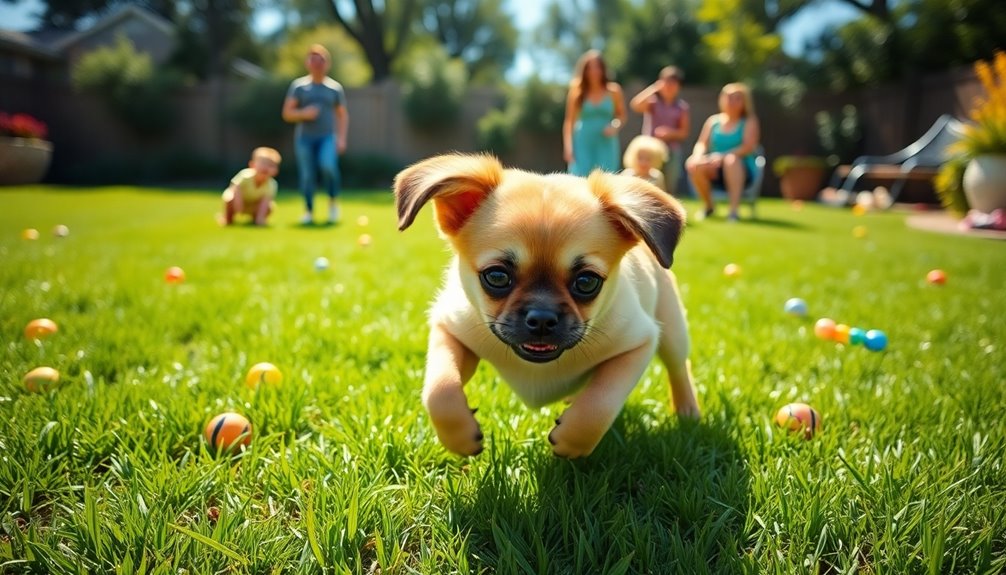
If you're looking for a playful companion, puggles are perfect for active families.
They need about 30 minutes of exercise daily, which can easily fit into your routine with walks or energetic play. Additionally, their high energy levels necessitate ample stimulation to keep them happy and engaged. Engaging them with educational toys can enhance their mental stimulation while you play together.
Plus, their adaptable nature means they can thrive in various living environments, as long as they get the physical activity they crave.
Great for Playful Families
Puggles make excellent companions for playful families, thanks to their affectionate and gentle nature. They form strong bonds with family members, inheriting the Pug's love for human company. Their patient demeanor makes them a great fit for families with children, as they can handle a bit of rough-and-tumble play. Supervised interactions ensure safety, but you'll find that Puggles love engaging in fun activities with kids of all ages.
These dogs thrive in social households, enjoying the company of new people and other pets. Their friendly and sociable nature means they often get along well with other animals, especially when properly socialized from a young age.
You'll appreciate how adaptable they are, fitting into various living environments, whether you're in an apartment or a suburban home.
Puggles are loyal and loving, relishing the attention and affection you give them. You'll find them eager to join in on family activities, making them ideal playmates for your kids.
With a Puggle by your side, your family dynamic will be even more vibrant and full of joy, making every day an adventure together.
Exercise Needs and Space
For active households, Puggles thrive on regular exercise and playtime to keep them happy and healthy. They need about 30 minutes of physical activity each day, which can include walks, energetic play around the house, or short bursts of outdoor fun.
To prevent boredom, it's crucial to provide mental stimulation, as Puggles can engage in undesirable behaviors like digging or excessive barking if they feel cooped up.
Due to their shorter snouts, Puggles aren't suited for running or jogging, so you'll want to avoid strenuous activities and take care to prevent overheating in hot weather.
These dogs adapt well to indoor living, making them great companions for moderate-sized apartments or small homes. They don't need large spaces but do require room to zoom and play energetically.
A small yard or balcony works perfectly for their playtime needs, and they thrive in social environments.
With a flexible living arrangement, as long as you provide exercise and attention, your Puggle will flourish in various settings.
Just remember to keep their activity varied to keep them engaged and happy!
Frequently Asked Questions
Are Puggles Good With Children and Other Pets?
When considering if a dog is good with children and other pets, you'll find that many breeds are generally gentle and playful. These traits make them suitable companions for kids of all ages.
If you're planning to introduce a new pet, early socialization is key. Monitor interactions to ensure everyone gets along well.
With proper training, patience, and supervision, dogs can thrive in a family setting and coexist peacefully with other pets.
How Much Exercise Do Puggles Need Daily?
Puggles need about 30 to 40 minutes of exercise each day. You can achieve this through a few short walks or energetic playtime in your yard.
Keep in mind that their exercise needs vary based on age and energy levels. Puppies might prefer short bursts of activity, while adults require more consistent exercise.
Mixing walks, play, and mental stimulation will help keep your Puggle healthy, happy, and well-behaved.
What Are Common Behavioral Issues in Puggles?
Common behavioral issues in Puggles include separation anxiety, which can lead to barking or destructive behavior when left alone.
You might notice excessive panting due to stress, especially in hot conditions. They crave companionship, so loneliness can trigger acting out.
Additionally, lack of mental and physical stimulation often results in unwanted behaviors like chewing or excessive barking.
Lastly, changes in routine can increase anxiety, making consistent training and socialization essential.
Do Puggles Shed a Lot of Fur?
Yes, puggles do shed a lot of fur. They inherit a short, shiny coat from their Beagle parent, but that doesn't mean they're low-shedding.
You'll notice seasonal shedding, especially during spring and fall, and even indoor puggles may shed consistently throughout the year.
Regular grooming, like brushing once a week, can help manage this shedding and keep your home fur-free. A healthy diet also plays a role in minimizing excess fur loss.
Can Puggles Live in Apartments?
Yes, Puggles can definitely live in apartments! Their moderate size makes them well-suited for smaller spaces.
You won't need a large area for them to thrive; just enough room for their bed, food, and some toys. Regular short walks and playtime will keep them happy and healthy.
As long as you provide mental stimulation and avoid strenuous exercise in extreme weather, your Puggle will adapt perfectly to apartment living.
Conclusion
In conclusion, the puggle's playful nature and charming personality make it a fantastic companion for active households. With their unique blend of beagle and pug traits, they thrive in environments that encourage exercise and social interaction. Whether you're training for agility sports or just enjoying a daily walk, these lovable pups keep you on your toes. If you're looking for a fun-loving friend to join your adventures, a puggle might just be the perfect fit for you!

